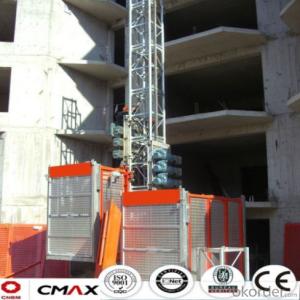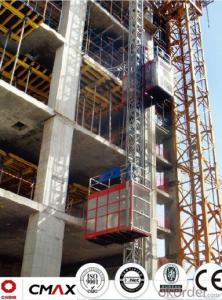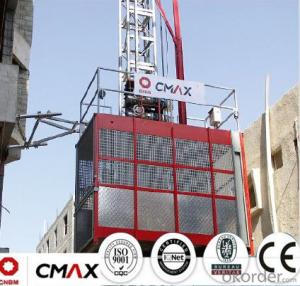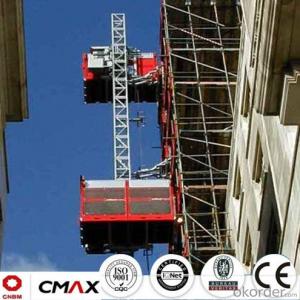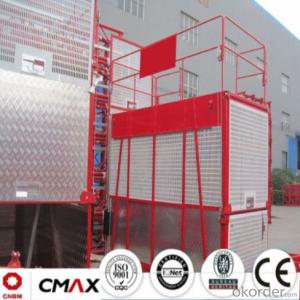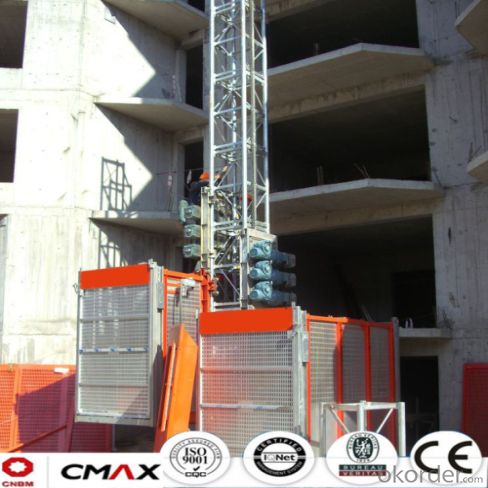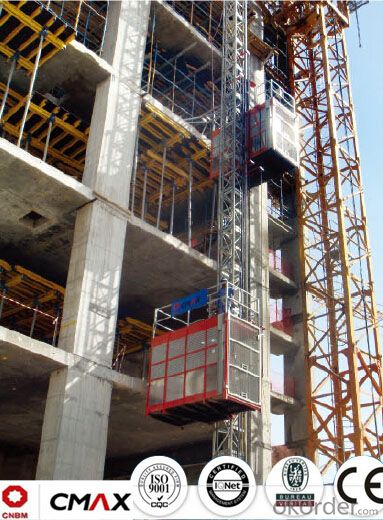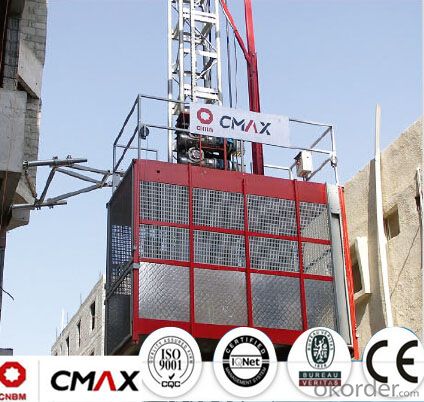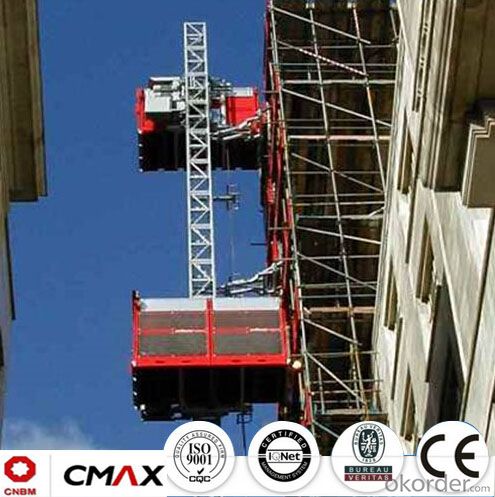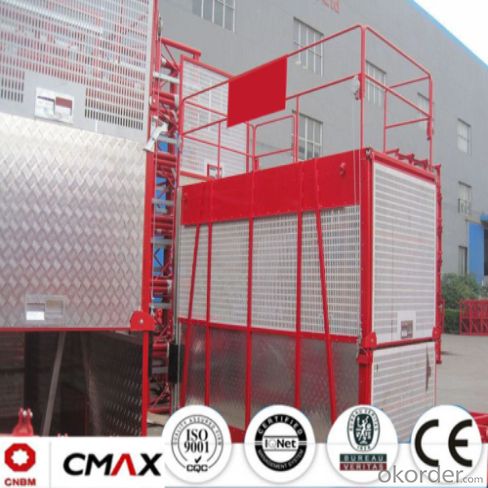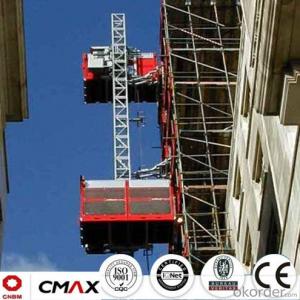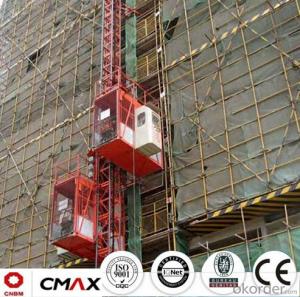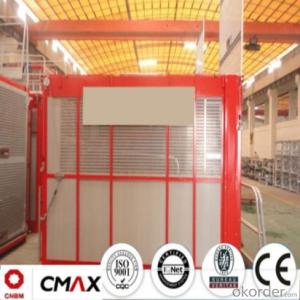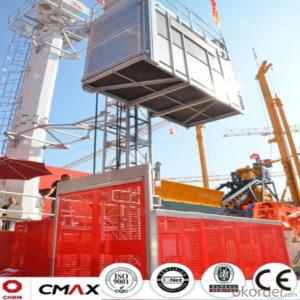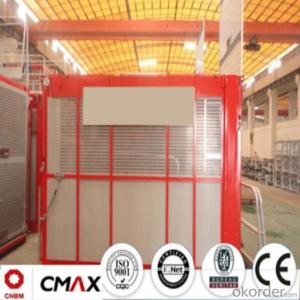Building Hoist European Standard Electric Spare Parts with 5ton Capacity
- Loading Port:
- China main port
- Payment Terms:
- TT OR LC
- Min Order Qty:
- 1 unit
- Supply Capability:
- 5 unit/month
OKorder Service Pledge
OKorder Financial Service
You Might Also Like
Structure of Building Hoist Description
1.The gearing select perfect bearing,strong cables and oil seal.
2.The electrical parts select products from famous world manufacturers for example Schneider,Siemens and LG.
3.The racks and pinion select advanced material and advanced technique,which enhance the life of all parts.
4.The steel structure adopted strong steel from famous native manufacturers.
5.The surface of the steel structure can adopt paint-spray,parkerizing baking finish or hot galvanizing processing depending on users requirement.
6.The cage can be made and decorated by aluminum molded board,punched-plate or figured aluminum board.
Packaging & Delivery of Building Hoist
Packaging: nude and wooded box Delivery: 25-30days
Mains Parts of Building Hoist
1.The steel structure for example the mast, tie in and cabin ,could be all spay-painted and hot galvanized. Mast section is made with high quality Q345B which is the top standared in China.
2.Electrical parts are all adopted with Schneider , Siemens and other famous brands.
3.The electrical system can be selected with the normal control method and VVVF+PLC control way. Inverter we selected is from Schneider. Yaskawa or other world renowned brand.
4.Cabin exit door select ramping type. The ramping door looks like a bridge between the construction hoist and construction building.
5.The cabin floor is made from 3MM thickness steel riffled board(Hot dip galvanized), and 15MM thickness wooden board which can reduce the vibration and deformation a lot.
6.Driving unit is adopted the products from ZHANGJIANG and other reputed maker, or from SEW, NORD.
7.Safety system is mainly composed of electrical motor braking, anti-drop safety device, top & bottom limit switches, top & bottom 3-phase switches, door limit switches, buffer device and over-load protection. The system aims to ensure the hoist are running safely.
8.Qualification: CE, ISO9001:2008 and etc.
9.The long-term operation of CMAX building hoists testifies CMAX hoist is working performance is stable.
Building Hoist Images



Building Hoist Specification

FAQ of Building Hosit
Q: What is the building hoist main purpose?
A: Building hoist equipped with double or single cabin to transport the materials and labors up and down. It's the ideal construction equipment for vertical transportation in the field of construction.
Q: What is the main structure of building hoist?
A: The P/M construction hoist mainly contains metal structure, driving system, electrical control system, cable guide & protection system, electrical top crane and safety device.
Q: What is the meaning of the building hoist’s code?
A: Take SC200/200 for example: “SC” stands for rack and pinion hoist, “200/200” stands for double cage and capacity is 2 tons per cage. “SC200” stands for single cage and capacity is 2 tons.
Q: What is the dimension of the cage?
A: Normally the cage dimension is 3X1.5X2.5M (L/W/H) for 2t type hoist. Details should be checked according to our
quotation sheet. Also, the size can be customized according to the factual site condition. There are two doors (entrance& exit doors) for each cage, It can be produced as up & down sliding or ramping model for safety and convenience.
- Q: Describe the routine maintenance and inspection procedures for a building hoist.
- <p>The maintenance and inspection process for a building hoist involves several key steps to ensure safety and functionality. Regular visual inspections should be conducted to check for any visible damage or wear. Monthly inspections should include testing the emergency stop and limit switches, as well as lubricating moving parts. Quarterly inspections may involve checking the electrical connections and verifying the correct operation of safety devices. Annual inspections typically require a thorough examination by a qualified person, including testing the load-bearing capacity and ensuring all safety features are in good working order. Additionally, records of all inspections and maintenance should be kept for reference and compliance with safety regulations.</p>
- Q: Explain the distinctions between electric and hydraulic power sources used in building hoists.
- <p>Electric hoists use electric motors to generate power, which is more environmentally friendly and requires less maintenance. They are often quieter, easier to control, and can be more energy-efficient. Hydraulic hoists, on the other hand, rely on fluid pressure to generate power. They can provide greater lifting capacity and are often used in heavy-duty applications. Hydraulic systems can be more complex to maintain and repair, and they may not be as energy-efficient as electric hoists. However, they offer smooth and controlled lifting, which is beneficial in certain construction scenarios.</p>
- Q: This question asks about the measures taken to guarantee the safety and reliability of lifting equipment prior to its use in construction.
- <p>To ensure that lifting equipment is safe and reliable before using it in construction work, several key steps must be taken. Firstly, regular inspections and maintenance are crucial to identify any potential issues or wear and tear. Secondly, all equipment should be thoroughly tested and certified by qualified personnel to meet safety standards. Thirdly, proper training for operators is essential to ensure they understand how to use the equipment safely. Additionally, having a comprehensive safety plan in place, including emergency procedures, can help prevent accidents. Lastly, using equipment from reputable manufacturers and ensuring all components are in good working order are also vital for maintaining safety and reliability.</p>
- Q: How do construction suspension scaffolding be handled in the people's elevator?
- You need to transfer at the scaffold poling build-up on the cantilever beams, and one cargo lift scaffolding and scaffolding disconnect processing, so that not only is the stress problem, and is an outer layer removed, people transfer the general is still there, easy to keep people transfer at the shelf.
- Q: The question asks about the typical duration a building hoist can function before needing replacement or significant repair.
- <p>The lifespan of a building hoist can vary significantly based on factors such as usage frequency, maintenance, and the quality of the hoist itself. Generally, with proper care and regular maintenance, a building hoist can last anywhere from 10 to 20 years. However, heavy usage and inadequate maintenance can shorten this lifespan, while some high-quality hoists may exceed the average lifespan with fewer issues.</p>
- Q: Is it feasible to repair or replace a building hoist with ease?
- <p>The ease of repairing or replacing a building hoist depends on several factors. For minor issues, repairs can often be done relatively easily by trained technicians. However, for major malfunctions or when a hoist is outdated, replacement might be necessary. This process can be complex and requires expertise to ensure safety and compliance with building codes. Factors such as the hoist's age, the complexity of the system, and the availability of replacement parts play a significant role in determining the ease of repair or replacement. In some cases, it might be more cost-effective to replace rather than repair, especially if the hoist is old or if repair costs are high.</p>
- Q: Explain the differences between electric and electric-hydraulic lifting equipment, highlighting their mechanisms and applications.
- <p>Electric lifting equipment operates on electric motors that directly drive the lifting mechanism, such as in electric hoists or cranes. This type of equipment is known for its simplicity, low maintenance, and precision control. On the other hand, electric-hydraulic lifting equipment uses an electric motor to power a hydraulic pump, which in turn moves hydraulic fluid to operate the lifting mechanism. This type is characterized by high lifting capacity, smooth operation, and the ability to handle heavy loads. Electric-hydraulic systems are often used in applications requiring significant force, such as in heavy machinery and construction equipment.</p>
- Q: Describe the process of utilizing a computer control system for operating a building hoist.
- <p>To use a computer control system for a building hoist, first ensure the system is properly installed and integrated with the hoist's mechanical and electrical components. Begin by powering on the control system and checking for any error messages that might indicate a problem. Once the system is ready, input the desired parameters such as load weight, lifting height, and speed settings. Use the control panel to initiate the hoist's movement, monitoring the progress on the system's display. Adjust the hoist's operation in real-time as needed, ensuring safety protocols are followed. Regularly check system diagnostics for maintenance alerts and address any issues promptly to maintain optimal performance.</p>
- Q: Is it possible to utilize a building hoist for the purpose of raising construction materials or machinery?
- <p>Yes, a building hoist is specifically designed for lifting materials and equipment in construction settings. It is a temporary vertical transportation system used to move materials, tools, and sometimes personnel between different floors of a building under construction. Building hoists are essential for efficient construction processes, ensuring that materials are delivered to the correct levels without the need for manual labor, which can be time-consuming and hazardous.</p>
- Q: What is the meaning of double straps in the construction elevator?
- With double cage for heavy, namely SCD200/200 series Is the two cages, each cage has a corresponding weight, the weight up and down in the elevator cage rise to energy conservation and reduce the reaction between the up and down, when you imagine front-rear door principle is about the same
Send your message to us
Building Hoist European Standard Electric Spare Parts with 5ton Capacity
- Loading Port:
- China main port
- Payment Terms:
- TT OR LC
- Min Order Qty:
- 1 unit
- Supply Capability:
- 5 unit/month
OKorder Service Pledge
OKorder Financial Service
Similar products
Hot products
Hot Searches
Related keywords
